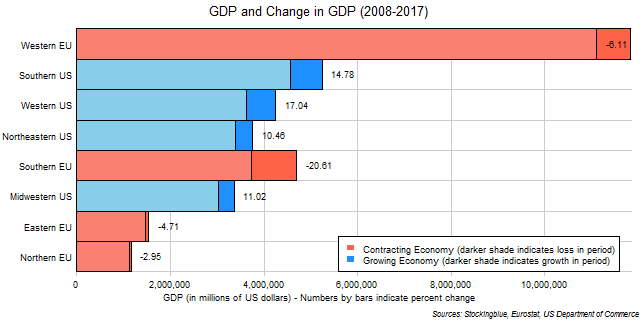
The chart above shows the GDP and change in GDP over the last ten years in EU and US regions in US dollars. All four US regions grew in the past ten years while all four EU regions shrank in the past ten years (when priced in US dollars).
Findings
- The difference between the region with the greatest absolute growth in GDP, the Southern US, and the region with the least, the Midwestern US, is $340,526,000,000.
- The Southern US has 2.02 times the absolute economic growth that the Midwestern US does in the past ten years.
- The Southern EU went from being the second largest regional economy in the EU and US to the fifth as the Southern, Western, and Northeastern US surpassed it.
Caveats
- All percentages are rounded to the nearest hundredth.
- EU and US data come from different sources.
- EU data was converted from euros to dollars at the average 2008 0.68 euros to dollars rate and the 2017 0.88 euros to dollars rate.
- The Western EU consists of Germany, United Kingdom, France, Netherlands, Belgium, Austria, Ireland, and Luxembourg.
- The Southern US consists of Texas, Florida, Georgia, North Carolina, Virginia, Tennessee, Louisiana, South Carolina, Alabama, Kentucky, Oklahoma, Arkansas, Mississippi, and West Virginia.
- The Western US consists of California, Washington, Colorado, Arizona, Oregon, Utah, Nevada, New Mexico, Hawaii, Idaho, Alaska, Montana, and Wyoming.
- The Northeastern US consists of New York, Pennsylvania, New Jersey, Massachusetts, Maryland, Connecticut, New Hampshire, Delaware, Maine, Rhode Island, and Vermont.
- The Southern EU consists of Italy, Spain, Portugal, Greece, Cyprus, and Malta.
- The Midwestern US consists of Illinois, Ohio, Michigan, Indiana, Minnesota, Wisconsin, Missouri, Iowa, Kansas, Nebraska, North Dakota, and South Dakota.
- The Eastern EU consists of Poland, Czech Republic, Romania, Hungary, Slovakia, Bulgaria, Croatia, Slovenia, Lithuania, Latvia, and Estonia.
- The Northern EU consists of Sweden, Denmark, and Finland.
Details
Although the EU regions' economies all grew when priced in euros, their economies all shrank when priced in US dollars (using the same currency allows for a better comparison between states that use different currencies - if the base currency was the euro, the US regions would have simply grown at an even faster pace).
Although the Western US had the greatest relative growth at 17.04%, the Southern US had the greatest absolute growth at $674,626 million. As far as contracting economies go, the Southern EU had both the greatest relative contraction at 20.61% or just over one-fifth of its economy lost and the greatest absolute contraction $968,354 million or just under one billion US dollars lost in the ten year period.
The European Union as a whole shrank by $1,797,678 million over the ten year period. The United States as a whole grew by $1,982,473 million over the ten year period.
Sources
Eurostat. 2018. "Eurostat - Tables, Graphs and Maps Interface." Accessed June 26, 2018. http://ec.europa.eu/eurostat/tgm/table.do?tab=table&init=1&language=en&pcode=tec00001&plugin=1.
US Department of Commerce. 2018. "US Bureau of Economic Analysis." Accessed June 26, 2018. https://bea.gov/itable/iTable.cfm?ReqID=70&step=1#reqid=70&step=10&isuri=1&7003=1000&7035=-1&7004=naics&7005=1&7006=01000,02000,04000,05000,06000,08000,09000,10000,11000,12000,13000,15000,16000,17000,18000,19000,20000,21000,22000,23000,24000,25000,26000,27000,28000,29000,30000,31000,32000,33000,34000,35000,36000,37000,38000,39000,40000,41000,42000,44000,45000,46000,47000,48000,49000,50000,51000,53000,54000,55000,56000&7036=-1&7001=11000&7002=1&7090=70&7007=2017,2016,2015,2014,2013,2012,2011,2010,2009,2008,2007,2006&7093=levels.